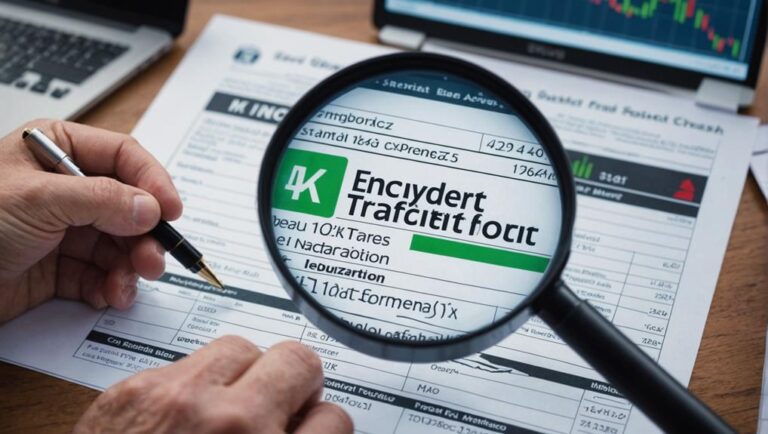SEC Form 4: Ensuring Accountability in Company Stock Ownership Changes

SEC Form 4 serves as a crucial tool for ensuring transparency in stock transactions involving company insiders. This form mandates directors, officers, and significant shareholders to promptly report their transactions, typically within two business days.
By requiring this disclosure, Form 4 plays a vital role in preventing insider trading and providing real-time insights into these transactions. The information disclosed in Form 4, including transaction dates, types of securities involved, and remaining shares, helps hold individuals accountable and promotes market integrity.
Timely filing of Form 4 is essential to avoid penalties and maintain compliance with regulatory requirements. Failure to adhere to the reporting deadlines can lead to severe consequences, highlighting the significance of following the disclosure regulations.
By requiring insiders to disclose their stock transactions promptly, Form 4 contributes to investor confidence and enhances market efficiency.
In summary, the proper filing of SEC Form 4 is critical for upholding transparency and accountability in stock transactions involving company insiders. By mandating timely disclosure of ownership changes, Form 4 plays a key role in preventing insider trading and maintaining market integrity. Compliance with Form 4 requirements not only benefits investors by providing valuable information but also contributes to overall market efficiency.
Key Takeaways
SEC Form 4 mandates prompt disclosure of stock ownership changes by company insiders, enhancing accountability. This requirement aims to prevent insider trading by offering transparency into significant transactions by directors, officers, and major shareholders. Filing within two business days ensures investors access real-time data for informed decision-making, fostering market integrity and trust.
Accurate reporting of both direct and indirect ownership levels is crucial for maintaining the credibility of financial markets. By promptly disclosing changes in stock ownership, Form 4 helps to deter unethical behavior and reinforce investor confidence in the market. Penalties for late or inaccurate filings serve as a deterrent, emphasizing the importance of timely and precise reporting to uphold market transparency and fairness.
Importance of SEC Form 4
SEC Form 4 plays a crucial role in ensuring transparency in stock transactions involving company insiders. When directors and officers decide to exercise their options or conduct any stock transaction, they're obligated to submit this form to the Securities and Exchange Commission (SEC). This submission must occur within two business days, ensuring that the necessary information on Form 4 is promptly made public.
The significance of SEC Form 4 in preventing insider trading can't be overstated. By requiring the disclosure of these transactions, Form 4 provides investors with valuable insights into the buying and selling activities of individuals with substantial influence within a company. Whenever there are significant changes in ownership, the form offers a real-time reflection of insider sentiment, empowering investors to make more informed decisions.
Furthermore, Form 4 is part of a series of SEC forms that collectively enhance transparency and accountability in financial markets. The mandatory and public nature of this document allows for the tracking of ownership changes by key stakeholders such as directors and officers, promoting a fair and level playing field.
Understanding the importance of SEC Form 4 enables us to recognize the mechanisms in place to uphold market integrity and foster trust among investors.
Key Components of Form 4
In Form 4, we accurately report changes in ownership and provide detailed information about the transactions. This includes specifying transaction dates, types of securities involved, and the quantity of shares purchased or sold.
It's crucial to disclose any derivative securities and indicate the conversion dates to ensure complete transparency.
Reporting Ownership Changes
When filling out Form 4 to report ownership changes, it's crucial to include key details such as the reporting person's name, company name, and transaction date. This level of transparency is essential for compliance and for fostering trust with investors and stakeholders.
Specific information like the type of security involved and the number of shares bought or sold must be provided. It's also important to disclose the remaining shares held after the transaction to ensure accurate reporting.
In addition to the basic components, it's essential to include details on derivative securities, including their conversion dates. Any indirect ownership through entities such as trusts or accounts must also be reported. Providing comprehensive information on the underlying securities is necessary to give a clear picture of the transaction.
Furthermore, clearly stating the reporting person's relationship to the company is crucial for transparency.
To ensure accuracy, each transaction, especially those involving different roles or security classes, should be reported on separate lines. This meticulous approach not only meets regulatory requirements but also demonstrates a commitment to ethical and responsible reporting practices.
Transaction Types Explained
Understanding the transaction types covered by Form 4 is crucial for accurately interpreting insider trading activities and gaining insights into insider behavior. Form 4 includes different types of stock transactions, each with specific codes that indicate the nature of the activity, providing us with a deeper understanding of how insiders interact with company stock.
The transaction types under Form 4 include:
- Open Market Purchases: This type involves insiders buying company stock directly from the open market (Code: P). It often signifies the insider's confidence in the company's future prospects.
- Option Exercises: In this category, insiders exercise their stock options to convert them into shares (Code: M). This action typically reflects strategic financial planning by the insider.
- Sales: Insiders selling their shares in the company fall under this type of transaction (Code: S). While it could indicate profit-taking or a need for liquidity, it may also raise concerns about the insider's belief in the company's future performance.
Who Must File Form 4

Directors, officers, and beneficial owners holding 10% or more of a company's outstanding shares are mandated by the SEC to file Form 4 to report any changes in their stock ownership. This requirement ensures accountability in stock ownership changes and helps uphold market integrity. As insiders of registered companies, these individuals must file Form 4 to monitor alterations in beneficial ownership of securities.
Filing Form 4, as required by the SEC, plays a crucial role in promoting transparency, preventing insider trading, and fostering trust in market activities. The significance of this filing lies in several key aspects:
- Accountability: Form 4 mandates that company insiders maintain transparency regarding their stock transactions.
- Transparency: It offers the public timely updates on significant ownership changes within the company.
- Prevention: By making stock transactions visible, Form 4 helps deter insider trading.
- Trust: It contributes to building investor confidence in the fairness of the marketplace.
- Compliance: Ensures companies comply with SEC regulations to avoid penalties.
Adhering to the SEC's requirement to file Form 4 not only benefits the individuals involved but also contributes to the overall integrity and transparency of the stock market.
Deadlines for Filing
Let's delve into the deadlines for filing Form 4, which necessitates insiders to report significant stock transactions within two business days.
This prompt disclosure is crucial for upholding transparency and accountability in the market, as investors rely on timely data to make well-informed choices.
Failure to meet these deadlines can result in substantial penalties, such as civil and criminal actions, underscoring the significance of complying with SEC regulations.
Filing Requirement Timeline
Insiders must promptly submit SEC Form 4 within two business days of significant transactions involving changes in their stock ownership. This strict filing deadline is crucial for upholding transparency and accountability in insider dealings. Timely completion of Form 4 enables the SEC to effectively monitor these activities, safeguarding the integrity of the securities market.
Failure to meet the filing deadline can result in serious consequences, including civil or criminal actions. The SEC enforces these deadlines rigorously to deter any potential misuse of insider information. Adhering to the filing requirement timeline is essential for several reasons:
- Prevents market manipulation: Prompt filings help maintain a fair market for all participants.
- Enhances investor confidence: Transparent insider transactions contribute to building trust among investors.
- Reduces legal risks: Meeting deadlines helps mitigate the risk of facing civil or criminal actions.
- Promotes accountability: Insiders are held accountable for their actions through timely disclosures.
- Supports market integrity: Quick disclosure of ownership changes contributes to maintaining a level playing field in the market.
Immediate Disclosure Necessity
Ensuring immediate disclosure within two business days is crucial for maintaining market transparency and preventing insider trading. Timely Form 4 filings guarantee that any significant transaction involving changes in stock ownership by insiders is promptly shared with the public. This quick disclosure is vital for monitoring insider activities and creating a fair environment for all investors.
Adhering to the two-business-day deadline promotes accountability and integrity in our financial markets. This commitment helps deter potential manipulation or misuse of insider information, ultimately preserving trust in the system. Transparent transactions are essential for stakeholders, providing them with the necessary information to make well-informed decisions.
Non-compliance with these deadlines can result in severe consequences, such as civil or criminal actions. Therefore, it's crucial for insiders to grasp the significance of timely reporting. Form 4 filings act as a public record, serving as a deterrent against unethical conduct and ensuring that all individuals are held responsible for their actions.
Immediate disclosure isn't only a regulatory obligation but also a cornerstone of market integrity and investor trust.
Penalties for Delays
Failure to submit Form 4 within the mandated two-business-day timeframe can lead to substantial penalties, including civil or criminal repercussions. As insiders, it's crucial to meet strict filing deadlines for reporting alterations in beneficial ownership, ensuring timely disclosure of insider transactions. Delays in submission not only attract regulatory attention but also carry severe legal ramifications, compromising our accountability and transparency.
The repercussions for missing these deadlines are structured to emphasize the significance of prompt disclosure. The potential consequences include:
- Civil penalties: Monetary fines or sanctions enforced by the SEC.
- Criminal consequences: Potential imprisonment for egregious non-compliance.
- Regulatory scrutiny: Heightened oversight and possible erosion of investor confidence.
- Reputational damage: Diminished stakeholder trust in our governance.
- Operational disruptions: Resources and time diverted to address compliance issues.
Incorporating innovative tools into our processes can help prevent these pitfalls. By utilizing advanced compliance solutions and integrating automated alerts into our systems, we can ensure timely submissions and uphold the highest standards of accountability.
Let's embrace technology to mitigate risks and promote a culture of transparency, ensuring that our insider transactions are consistently disclosed within the required timeframe.
Common Mistakes to Avoid

One common mistake we often see is the failure to promptly disclose changes in stock ownership within the mandated two business days, leading to potential legal repercussions. It's essential to be vigilant and timely in reporting these changes on Form 4 to comply with regulatory requirements.
Another prevalent error is inaccurately reporting indirect ownership through trusts or accounts, which can obscure the true nature of stock ownership and should be avoided at all costs. It's crucial to accurately report different roles or security classes on separate lines to maintain transparency and clarity in disclosures.
In the case of derivative securities, omitting essential details such as conversion dates and underlying securities frequently results in incomplete filings. This not only impacts the accuracy of the Form 4 but also undermines the reliability of insider trading information, compromising the integrity of financial disclosures.
To uphold a high standard of transparency and accountability, it's imperative to meticulously review our filings for common mistakes. By avoiding errors like these, we demonstrate our commitment to maintaining trust with regulators and investors.
Let's prioritize precise reporting and adhere to the highest standards in our financial disclosures.
Comparing Forms 3, 4, and 5
Understanding SEC Form 4 is crucial for monitoring and reporting changes in ownership of company stock by insiders. Form 4 plays a pivotal role in ensuring timely disclosure of material changes in insider ownership. It mandates electronic filing via EDGAR within two business days, guaranteeing swift reporting to investors. By promptly disclosing insider transactions, Form 4 enhances transparency in the market and allows investors to make informed decisions.
Compliance with SEC regulations is a key aspect of Form 4. Companies and insiders are required to adhere to the legal requirements set forth by the SEC to maintain integrity in the financial markets. Failure to disclose changes in ownership can lead to civil or criminal actions, emphasizing the importance of accurate and timely filing of Form 4.
Investors benefit from the accurate monitoring of insider activities facilitated by Form 4. By tracking changes in beneficial ownership, investors can gain insights into the sentiment and confidence of company insiders. This information can be crucial in assessing the future performance and direction of a company, helping investors make well-informed investment decisions.
In conclusion, SEC Form 4 is a vital tool for ensuring transparency and integrity in the financial markets. By requiring timely disclosure of changes in ownership of company stock by insiders, Form 4 plays a critical role in maintaining trust and confidence among investors.
Compliance with SEC regulations and accurate monitoring of insider activities are essential for upholding market integrity and preventing legal repercussions.
Steps to File Form 4

Before filing Form 4, it's crucial to access the SEC's EDGAR system and gather all the essential transaction details. Submitting Form 4 electronically via EDGAR within two business days of a significant transaction is vital for upholding transparency and preventing insider trading in stock dealings. Specific transaction details like the type of security, the quantity of shares bought or sold, and any remaining shares must be prepared beforehand.
Exceptions for paper filing are rare and usually granted only in extraordinary circumstances. When reporting, it's imperative to disclose any indirect ownership through trusts or accounts to ensure full transparency in every aspect of the transaction.
Form 4 plays a pivotal role in documenting these stock transactions, enforcing accountability, and maintaining a level playing field in the market. By meticulously recording each transaction, we contribute to a fairer and more transparent financial environment.
Understanding and adhering to these steps not only ensures compliance but also underscores our dedication to ethical practices in the marketplace. Timely and accurate filings uphold the integrity of our financial system, highlighting the significance of diligence and transparency in our operations.
Benefits of Filing Form 4
Filing Form 4 enhances transparency in insider stock transactions, providing investors with essential information to make well-informed decisions. By disclosing changes in beneficial ownership, Form 4 ensures that company insiders are held accountable for their stock ownership actions. This filing helps prevent insider trading, maintaining market integrity and fostering trust among investors.
The advantages of filing Form 4 include:
- Transparency: Investors gain insight into insider transactions that could impact their investment decisions.
- Accountability: Company insiders are required to disclose their stock ownership changes, promoting actions that benefit the company and its shareholders.
- Informed Decisions: Access to this information enables investors to make better choices when buying or selling shares.
- Market Integrity: SEC oversight and regulation help prevent unethical trading behaviors.
- Regulatory Compliance: Companies and insiders remain compliant with federal regulations, reducing the risk of legal complications.
Through SEC monitoring, Form 4 filings play a crucial role in upholding fairness and transparency in financial markets.
In today's information-driven world, these filings empower investors to navigate stock ownership complexities confidently and clearly.
Real-Life Examples

Real-life examples demonstrate the significance of SEC Form 4 filings in shedding light on insider transactions, influencing investor decisions and market dynamics. An illuminating case is Elon Musk's recent Form 4 filing for Tesla Inc. The filing provides detailed information on Musk's stock transactions, such as the type of security, number of shares, prices, and transaction dates, offering a transparent view of insider ownership changes. This transparency is crucial for upholding accountability and deterring unethical practices in stock transactions.
The SEC mandates prompt reporting of ownership changes through Form 4, ensuring vigilant monitoring of insider activities. This level of scrutiny empowers investors to conduct thorough analysis and make well-informed decisions. By closely tracking significant stock transactions like those of Musk, valuable insights into insider sentiment and potential market movements can be gained.
These filings serve as a valuable tool for investor analysis, furnishing real-time data that enhances market efficiency. The SEC's staunch commitment to transparency and accountability through Form 4 filings plays a pivotal role in maintaining a fair and ethical trading environment. As financial markets evolve, the significance of these disclosures can't be overstated.
Form 4 filings not only highlight notable stock transactions but also act as a deterrent against unethical practices, reinforcing investor confidence.
Frequently Asked Questions
What Is Form 4 Filing for Stocks?
SEC Form 4 is a mandatory filing required by the Securities and Exchange Commission (SEC) to disclose any changes in ownership of a company's stock by insiders. These insiders typically include directors, officers, and shareholders with more than 10% equity in the company. The purpose of Form 4 is to ensure transparency and accountability in the financial markets by providing timely information about executive transactions and ownership changes.
Failure to submit Form 4 in a timely and accurate manner can have serious consequences. It is essential for companies and insiders to comply with the filing requirements to prevent insider trading, protect shareholders' interests, and uphold the integrity of stock disclosures. Penalties may be imposed for any inaccuracies or delays in reporting transactions.
What SEC Filing Shows Stock Ownership?
SEC Form 4 is the go-to tool for tracking insider trades and ownership disclosures. It provides a detailed snapshot of executive shares, shareholder records, and equity transactions, ensuring compliance with regulations and enhancing transparency in stock movements.
This form is a crucial requirement for disclosing changes in ownership of company stock by insiders. It plays a vital role in providing investors and the public with essential information about who owns company shares and any recent changes in ownership.
What Does Code F Mean on SEC Form 4?
Code F on SEC Form 4 indicates that insider trading involves the conversion of derivative securities into shares. This code is used to report transaction dates, details of securities acquired, and ownership changes, ensuring compliance with regulations. Additionally, footnote explanations are provided to clarify the exercise price and the direct ownership of equity awards. This information is crucial for transparency and accountability in the financial markets.
What Is the SEC Rule for Beneficial Ownership Reporting?
We need to follow the SEC rule for reporting beneficial ownership to meet disclosure obligations. This rule requires insiders to report any changes in their ownership of company stock using Form 4. By adhering to these requirements, we ensure transparency in the market and avoid potential violations of reporting regulations. Insider trading activities, changes in shareholding, and ownership thresholds must be reported promptly to comply with SEC regulations and maintain the integrity of the financial markets. Failure to report within the specified deadlines can result in penalties and sanctions from regulatory authorities.
Conclusion
By mastering SEC Form 4, we ensure rock-solid accountability for changes in company stock ownership. This form serves as a crucial shield against corporate misconduct, shining a light on transparency within our organization.
By meeting deadlines, steering clear of common pitfalls, and grasping its intricacies, we fortify our company's integrity. Let's not overlook the significance of precise filings; they're the cornerstone of investor confidence and regulatory adherence.
Our meticulous focus on accuracy positions us as guardians of financial transparency.






